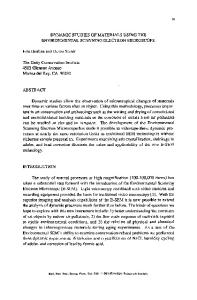Scan nonlinearity of a scanning electron microscope
- PDF / 228,734 Bytes
- 4 Pages / 595.276 x 793.701 pts Page_size
- 81 Downloads / 404 Views
SCAN NONLINEARITY OF A SCANNING ELECTRON MICROSCOPE
V. V. Alzoba,1 V. P. Gavrilenko,1 A. Yu. Kuzin,1 V. B. Mityukhlyaev,1 A. V. Rakov,1 P. A. Todua,2 and M. N. Filippov3
UDC 537.533.35
The scan nonlinearity of scanning electron microscopes is estimated with the use of a relief element with known geometric form of the profile. The mean value of the step of the test relief structure, which is determined as a test sample is moved along the scanning axis X, is measured. It is experimentally demonstrated that with a 5× magnification, the maximum relative deviation from the mean value of the step of the test structure for a given microscope does not exceed 0.4%. Keywords: scanning electron microscope, test relief step structure, scan nonlinearity.
Scanning electron microscopes are widely used for measurements of the linear dimensions of elements of the nanorelief of a surface with magnitudes of several dozen nanometers, for example, in measurements of key control characteristics in the production of electron microcircuits. In this range, estimation of the scan nonlinearity within the entire field of an observed frame is a critical step. The existence of significant nonlinearity leads to a dependence of the scale factor (magnification factor) on the site where the measured element is located in the image. This phenomenon has become one of the sources of the systematic error of linear measurements performed by means of scanning electron microscopes. The objective of the present study is to carry out an experimental estimation of the scan nonlinearity in a scanning electron microscope. Experimental Conditions. An image of the MShPS-2.0K relief step structure fabricated, in accordance with [1], with ten trapezoidal relief elements (ridges) was obtained on an S-4800 scanning electron microscope (Hitachi, Japan) with energy of the primary electrons E = 15 keV and working segment 5.0 mm. The eighth and tenth ridges were then photographed at 5× magnification (Fig. 1a). The sample was successively displaced in the direction of the horizontal axis (henceforth, the X-axis). The images of the indicated pair of ridges at ten successive positions along the X-axis were recorded with three photographs being produced at each position. A region 60 lines in width was selected in each of the video images in the same segment of the structure (Fig. 1a) and the region divided into three blocks each of 20 lines. The step was measured from the video signal obtained by averaging of the video signals from 20 lines in a block (Fig. 1b). Next, the mean value of a step was obtained by averaging of the steps obtained from the three blocks in each of the three images produced at the same position of the sample along the X-axis. The range of 60 lines was selected so as to minimize the influence of nonlinearity along the Y-axis.
1
Research Center for the Study of the Properties of Surfaces and Vacuum (NITsPV), Moscow, Russia; e-mail: [email protected]. Moscow Institute of Physics and Technology (MFTI), Dolgoprudnyi, Russia. 3 Kurnakov Institute of
Data Loading...










